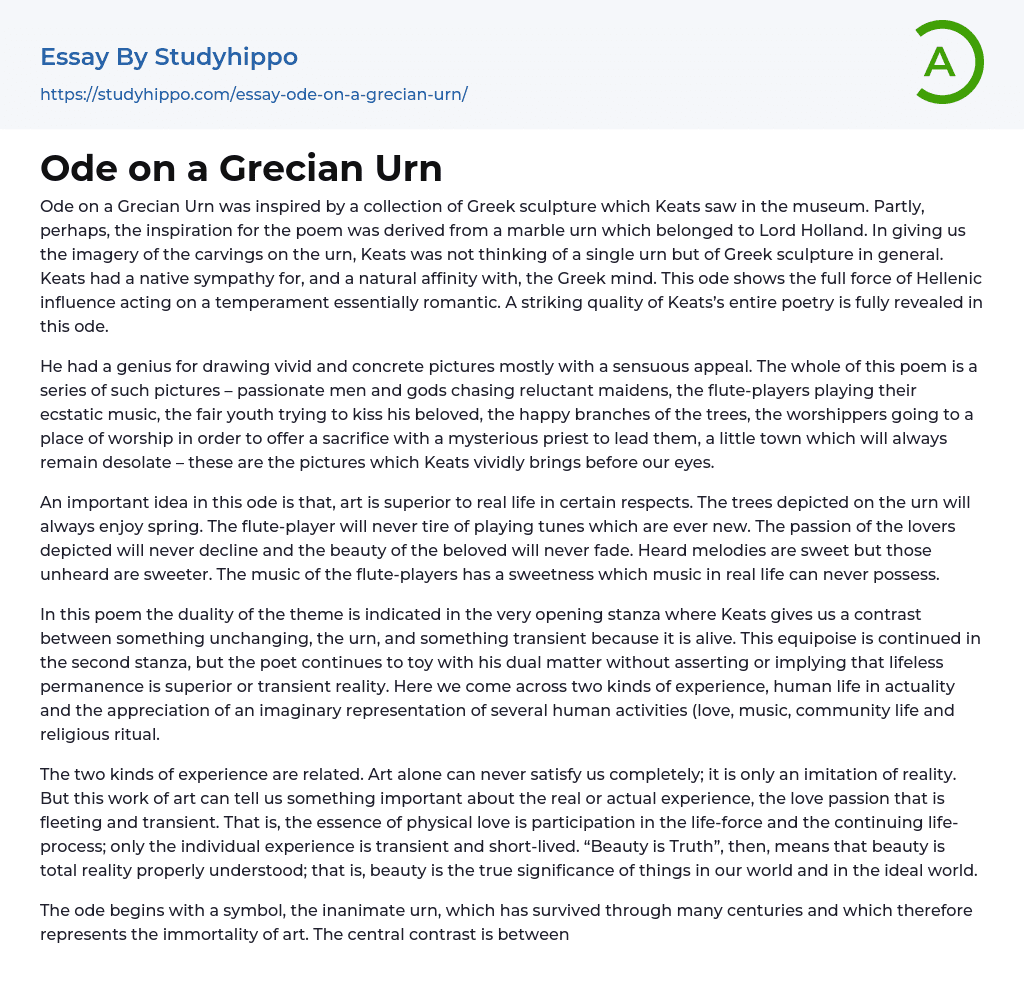Ode on a Grecian Urn was inspired by a collection of Greek sculpture which Keats saw in the museum. Partly, perhaps, the inspiration for the poem was derived from a marble urn which belonged to Lord Holland. In giving us the imagery of the carvings on the urn, Keats was not thinking of a single urn but of Greek sculpture in general. Keats had a native sympathy for, and a natural affinity with, the Greek mind. This ode shows the full force of Hellenic influence acting on a temperament essentially romantic. A striking quality of Keats’s entire poetry is fully revealed in this ode.
He had a genius for drawing vivid and concrete pictures mostly with a sensuous appeal. The whole of this poem is a series of such pictures – passionate men and gods c
...hasing reluctant maidens, the flute-players playing their ecstatic music, the fair youth trying to kiss his beloved, the happy branches of the trees, the worshippers going to a place of worship in order to offer a sacrifice with a mysterious priest to lead them, a little town which will always remain desolate – these are the pictures which Keats vividly brings before our eyes.
An important idea in this ode is that, art is superior to real life in certain respects. The trees depicted on the urn will always enjoy spring. The flute-player will never tire of playing tunes which are ever new. The passion of the lovers depicted will never decline and the beauty of the beloved will never fade. Heard melodies are sweet but those unheard are sweeter. The music of the flute-players ha
a sweetness which music in real life can never possess.
In this poem the duality of the theme is indicated in the very opening stanza where Keats gives us a contrast between something unchanging, the urn, and something transient because it is alive. This equipoise is continued in the second stanza, but the poet continues to toy with his dual matter without asserting or implying that lifeless permanence is superior or transient reality. Here we come across two kinds of experience, human life in actuality and the appreciation of an imaginary representation of several human activities (love, music, community life and religious ritual.
The two kinds of experience are related. Art alone can never satisfy us completely; it is only an imitation of reality. But this work of art can tell us something important about the real or actual experience, the love passion that is fleeting and transient. That is, the essence of physical love is participation in the life-force and the continuing life-process; only the individual experience is transient and short-lived. “Beauty is Truth”, then, means that beauty is total reality properly understood; that is, beauty is the true significance of things in our world and in the ideal world.
The ode begins with a symbol, the inanimate urn, which has survived through many centuries and which therefore represents the immortality of art. The central contrast is between the unending happiness arrested in art and the brevity of happiness in mortal life. Thus, in due course of the poem, Keats, after escaping to the world of beauty and permanence, finds himself compelled to return to the real world of impermanence and
suffering and to reach the conclusion that true beauty consists not in an escape from this world but an acceptance of it.
This ode represents the maturity and the height of Keats’s poetic power. His poetry is essentially imaginative and emotional, but his greatest poems possess also an intellectual appeal. Thus we have in this poem, an effective representation of an exquisite fusion of the imaginative, emotional, and intellectual elements. The moral of the urn, namely, that Beauty is Truth and Truth Beauty, has an intellectual basis.
But apart from this, the poem is charged with emotion and shows rich imagination. Keats’s genius for coining original, striking, and appropriate phrases is well evident in this poem. Sylvan historian”, “leaf-fringed legend”, “a heart high-sorrowful and cloy’d”, “cold pastoral”, and “fair attitude” are some of the examples. Moreover, the statement “Beauty is Truth, Truth Beauty”, is a neat and compact expression which is one of the most often quoted from English poetry. The language used undoubtedly sparkles with all the gems of speech, without their brilliance predominating over the conciseness and exactness of the whole. The rhythm used is perfectly adapted to the supreme unity of action.
- Creativity essays
- Art History essays
- Theatre essays
- Pastoral essays
- Visual Arts essays
- Postmodernism essays
- Symbolism essays
- ballet essays
- Color essays
- Modernism essays
- Mona Lisa essays
- Work of art essays
- Body Art essays
- Artist essays
- Cultural Anthropology essays
- Ethnography essays
- Aesthetics essays
- Realism essays
- Heritage essays
- Harlem Renaissance essays
- Concert Review essays
- Voice essays
- Theatre Of The Absurd essays
- Playwright essays
- Scotland essays
- Tennessee williams essays
- Design essays
- Graffiti essays
- Graphic essays
- Typography essays
- Painting essays
- Photography essays
- Sculpture essays
- Architecture essays
- Interior design essays
- Arch essays
- Area essays
- Tattoo essays
- Pablo Picasso essays
- Vincent Van Gogh essays
- Michelangelo essays
- Frida Kahlo essays
- Wall Street essays
- Dead Poets Society essays
- A beautiful mind essays
- Sherlock Holmes essays
- Our day out essays
- American Beauty essays
- Do The Right Thing essays
- Forrest Gump essays




